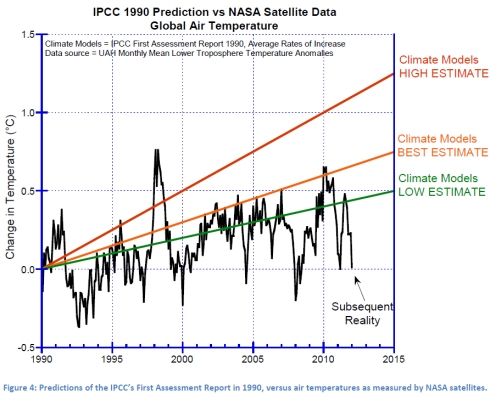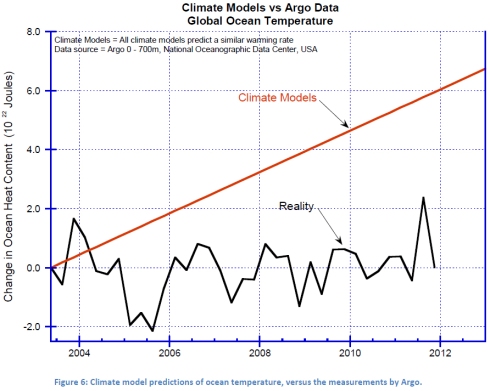Climate Coup: The Politics
April 24, 2012
How the regulating class is using bogus claims about climate change to entrench and extend their economic privileges and political control.
By DR. DAVID EVANS | SPPI | APRIL 24, 2012
THE SCIENCE
The sister article Climate Coup—The Science contains the science foundation for this essay. It checks the track record of the climate models against our best and latest data, from impeccable sources. It details how you can download this data yourself. It finds that the climate models got all their major predictions wrong:

The latter two items are especially pertinent, because they show that the crucial amplification by water feedbacks (mainly humidity and clouds),1 assumed by the models, does not exist in reality. Modelers guessed that of the forces on temperature, only CO2 has changed significantly since 1750. The amplification by water feedbacks causes two-thirds of the warming predicted by the models, while carbon dioxide only directly causes one third. The presence of the amplification in the models, but not in reality, explains why the models overestimated recent warming.
WHO ARE YOU GOING TO BELIEVE — THE GOVERNMENT CLIMATE SCIENTISTS OR YOUR OWN LYING EYES?
The climate models are incompatible with the data. You cannot believe both the theory of dangerous manmade global warming and the data, because they cannot both be right.
In science, data trumps theory. If data and theory disagree, as they do here, people of a more scientific bent go with the data and scrap the theory.
But in politics we usually go with authority figures, who in this case are the government climate scientists and the western governments—and they strongly support the theory. Many people simply cannot get past the fact that nearly all the authority figures believe the theory. To these people the data is simply irrelevant. Society needs most people to follow authority most of the time, just like an army needs soldiers who do not question orders.
The world’s climate scientists are almost all employed by western governments. They usually don’t pay you to do climate research unless you say you believe manmade global warming is dangerous, and it has been that way for more than 20 years.2 The result is a near-unanimity that is unusual for a theory in such an immature science.
SIDESHOWS INSTEAD OF THE WHOLE TRUTH
The government climate scientists and mainstream media have kept at least two important truths from the public and the politicians:
1. Two thirds of the warming predicted by the climate models is due to amplification by the water feedbacks, and only one third is directly due to CO2.
2. The dispute among scientists is about the water feedbacks. There is no dispute among serious scientists about the direct effect of CO2.
They seek to persuade with partial truths and omissions, not telling the truth in a disinterested manner. Instead, we are treated to endless sideshows. Issues such as Arctic ice, polar bears, bad weather , or the supposed psychological sickness of those opposing the authorities, tell us nothing about the causes of global warming. They divert public attention and the water feedbacks escapes scrutiny—hidden in plain sight, but never under public discussion.
THE SILENCE OF THE MAINSTREAM MEDIA
The data presented in Climate Coup—The Science is plainly relevant, publicly available, and impeccably sourced from our best instruments—satellites, Argo, and the weather balloons. Yet it never appears in the mainstream media. Have you ever seen it?
If the mainstream media were interested in the truth, they would seek out the best and latest data and check the predictions against the data. They don’t.
The newspapers are happy to devote acres of newsprint to the climate sideshows or to demonizing anyone who criticizes the theory. So why are they unwilling to publish the most relevant data?
Global warning has been a big issue for years. Yet all of the world’s investigative journalists—those cynical, hard-bitten, clever, incorruptible, scandal-sniffing reporters of the vital truths who are celebrated in their own press—all of them just happen not to notice
that the climate models get all their major predictions wrong? Really? Even though we point it out to them?
Good detectives do not overlook clues. The presented data contains half a dozen clues of brick-in-your-face subtlety. How could anyone miss them? Will the journalists who read this paragraph now follow the instructions on downloading the data, and report on what they find? No.
Perhaps they think it’s all too complicated, that it will make our brains hurt? A story with two numbers is too hard? No, we all understand a graph of temperature over time and can spot trends. Judging by the huge response on the Internet, the public want well-explained technical details about the climate.
The government climate scientists and their climate models said it would warm like this and heat up the atmosphere like that. But it didn’t, just download the data and check.
The media are withholding this data, so the “climate debate” is obviously not about science or truth. It must be about politics and power. Reluctantly, uncomfortably, the only possible conclusion is that the media don’t want to investigate the claims of the government climate scientists. Why? Who benefits?
Read Full Article →


